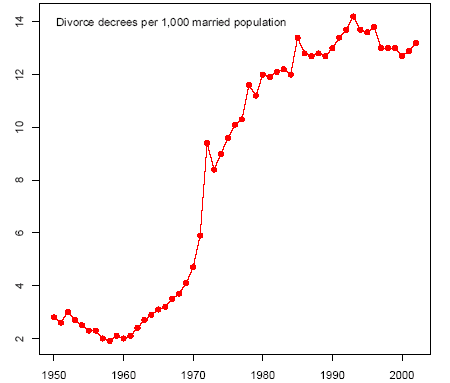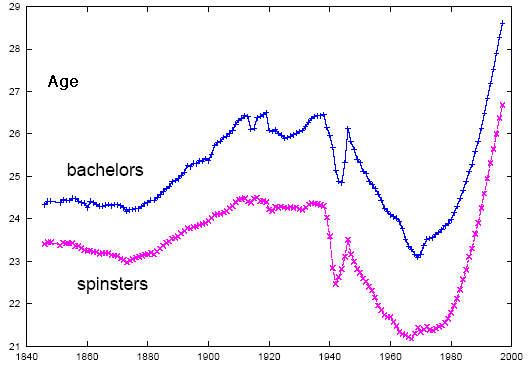
| Whilst divorce is a decision that is personal, social factors affect both the rates of divorce distributed among social groups and the change in the rate of divorce. This is where sociology comes in. |
| Our culture inherits values from the Christian tradition. Most Christians believe that marriage is for life. It is written into the marriage ceremony, "Those whom God has joined in Holy Matrimony, let no one put asunder till death do you part." |
| Jesus spoke directly against divorce and forbad it. |
| One of the Ten Commandments states, "Thou shalt not commit adultery." |
| Christian marriage is a sacrament (sacred act approved by God). As a result marriage was very difficult to end, and before the nineteenth century usually ended with death. Remarriage was for widows. People were careful before marrying, leaving it later and they died younger. |
| Islamic marriage is a contract not a sacrament. Therefore traditionally, a Muslim man can say, "I divorce thee" three times to obtain a divorce (it is usually more complicated than this even in Muslim countries). |
| Why are most Christian people against divorce? |

| One marriage in three ends in divorce. One child in five will see his or her parents divorce before the sixteenth birthday. |
| People who marry when they are still young are more likely to have a divorce. |
| People who are in the poorer groups of society are more likely to have a divorce than the wealthier and those with better jobs. |
| Husbands married to women who specialise as housewives are more likely to ask for a divorce on the grounds of adultery than husbands who are married to working wives. The women meet someone else in between all the housework! |
| Women are much more likely to ask for a divorce from their husbands (70%) than men are to ask for divorce from their wives (30%). |
| About a third of those who divorce have no children. |
| Most people divorce after about ten years of marriage. |
| Children from divorced families are more likely to divorce themselves. |
| Divorce is very expensive for society due to poverty that results among women who then need benefits or the work of the Child Support Agency. |
| Choose two of the above and suggest some reasons why in each case. |

| Legal changes, particularly in 1969 that allowed divorce when an irretrievable breakdown of marriage with two years separation for both agreeing and five years if only one wants it. |
| Divorce has lost much of its stigma; what was a disgrace is not more accepted. |
| People expect too much from specialised love marriages, and when the love goes so might the marriage. Other cultures unite families through arranged marriages, and these social functions may make them more stable. |
| Historical changes mean that divorces rise and fall according to events; they rose rapidly after the Second World War, and also with the period of social and sexual freedom from the 1960s when many younger marriages led to more young divorces (a vulnerable age group for divorcing). |
| Urbanisation leads to more chances of people of different cultures marrying and then finding a pressure to divorce from incompatibilities; that in the anonymous city fewer kinship and social ties exist to keep people married. |
| Independent women may refuse to accept traditional marriage roles and having become married into such a role they file for divorce. |
| "It would be better if marriage was arranged by the family." Discuss this with reference to some reasons for trends towards divorce. |
Divorce in the UK, Tak Wing Chan and Brendan Halpin
http://www.sociology.ox.ac.uk/swps/2001-01.pdf
|
| The independence hypothesis of divorce states that women with more economic independence are more likely to become divorced. |
| The median age of first marriage for women was 21.3 years in 1970 (23.2 for men) and 26.7 years in 1997 (28.6 for men) |
| Before the 1970s cohabitation before marriage was little known unless you had been married before; some 70% of the first marriages formed in the early 1990s involved cohabiting for around two years. |
| Divorce in England and Wales is now the highest in Europe and is rising towards two in five marriages failing. |
| So when it comes to marriage and divorce, economic considerations are very important, even if people say they marry for love. |
| Women have a bigger part to play in the jobs market today. Whilst marrying for economic reasons is less important for them, and so presumably they do it for love, nevertheless economic reasons are significant for divorce. Perhaps lack of personal fulfilment is important too. |
| Women with high wages have particularly high divorce rates if they also take up a heavy load of domestic work. They see this as unfair and it is also inefficient. They may as well be divorced. |
| It seems that having children is likely to increase not decrease divorce. It may be that men are removing themselves as fathers, or women regard their marriage as unjust in all the roles they do. |
Tak Wing Chan, Department of Sociology, University of Oxford Brendan Halpin, Department of Government and Society, University of Limerick (January 2001), Sociology Working Papers, Editors: Diego Gambetta and Michelle Jackson, Electronic editor: Edmund Chattoe, [Available, World Wide Web, Online: http://www.sociology.ox.ac.uk/swps/2001-01.html, http://www.sociology.ox.ac.uk/swps/2001-01.pdf] - charts from here.
| In what ways are changes to women's circumstances a driving force towards more divorce? |
|
|
| Discuss with reasons whether marriage is likely to survive as an institution. |
| 1857 | Divorce was made available through a Court of Law. Men could claim adultery. Women had to claim both adultery and cruelty. There was a guilty party. There was no divorce for the poor. |
| 1923 | Women could divorce on the same terms as men with still a guilty party. |
| 1937 | Desertion was added to the grounds for divorce |
| 1949 | Legal Aid was made available for divorce extending this to the poor. |
| 1969 | There is no longer a guilty party. Proof of irretrievable breakdown of marriage is required. |
| 1984 | The amount of time before application for divorce can be made was reduced. |
| 1996 | A law was not passed that would have made divorce mediation-based requiring counselling and consideration of children in this process. |
| Why might having divorce law combined with mediation be useful for the wellbeing of society? |